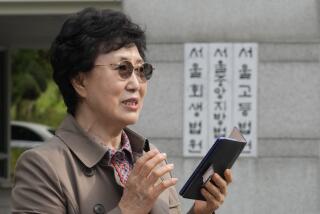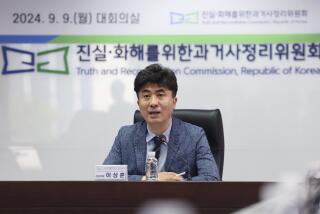Secret Times 3
- Share via
It seemed almost a miracle--three young men, strangers who had grown up in separate families, discovering by accident that they were identical triplets.
The public devoured their inspiring story as it made headlines around the country in 1980. The three, who had grown up in the New York area, appeared on “Good Morning America,” “Today,” “Donahue” and “Geraldo Rivera.” A movie was in the works.
But for all the media coverage, a side of this seemingly happy story has remained untold for 17 years, a secret about their childhood that stunned the triplets, Eddy Galland of New Hyde Park, David Kellman of Queens and Robert Shafran of Scarsdale.
For when they found one another at age 19, they also realized that they had been part of a human experiment, funded partly by the National Institutes of Health.
For years the same researchers came to each of their homes under the guise of conducting a “child development study.” Throughout their childhoods, their behavior had been charted, their personalities monitored, their relationships with their adoptive parents scrutinized. The same researchers had gone from the Gallands to the Kellmans to the Shafrans, never telling the boys or their parents the study’s true nature or that the boys’ identical siblings were living nearby.
Other children were studied, as well, including about a dozen pairs of identical twins put up for adoption through the same agency that placed the triplets--Louise Wise Services of New York City.
*
Seventeen years after they first learned of the study, the two surviving triplets still harbor feelings of anger.
“How can you do this with little children? How can you do this to a little baby--innocent children being torn apart at birth?” asked Shafran, who now lives in Brooklyn and is entering law practice.
Kellman, now of Maplewood, N.J., wonders why he couldn’t have grown up with his brothers. “We were robbed of 20 years together,” said Kellman, the proprietor of Triplets Roumanian Steak House in New York City.
The third triplet, Eddy Galland, committed suicide in 1995 at his home in Maplewood. He left behind a wife and a young daughter. Neither his widow nor his parents, Elliott and Annette Galland of Fort Lauderdale, Fla., responded to a request for an interview.
Their adoption agency had cooperated in developing the study, an apparently unprecedented project to monitor separated twins and triplets as they grew up. Researchers hoped it would shed light on the debate about environment vs. heredity.
A lawyer for Louise Wise Services, Nancy Ledy-Gurren, said the study involved twins placed by other adoption agencies, as well.
Today, advocates for adoptees voice outrage over the project, and several twins researchers and former adoption agency directors not involved in the study express discomfort over separating twins.
“I feel it’s a terribly destructive thing to do to separate siblings,” said Florence Anna Fisher, director of the Adoptees Liberty Movement Assn., a New York City advocacy group for adoptees. “I think it’s criminal to separate twins and triplets because they are attached in perpetuity. It’s like chopping off a limb.”
Dr. Thomas Bouchard, a leading twins researcher at the University of Minnesota, said he would “just never approve of separating subjects.” He added, “It just does not feel right to me.”
Partly because of that, Bouchard said, he had never requested data from Dr. Peter Neubauer, the New York City psychoanalyst who directed the study.
*
Neubauer, now 84, defended his work as important and said that the subjects would have been separated anyway under a policy of Louise Wise Services.
“They were not separated for research purposes,” Neubauer said. “They [Louise Wise Services] decided to do it, and then they came to me. When we learned about the policy, we decided it gives one an extraordinary opportunity for research.”
Ledy-Gurren said Louise Wise Services’ activities must be viewed in the context of the time in which they were carried out, when less emphasis was placed on keeping siblings together.
“There are many remedies that don’t stand the test of time but nevertheless had validity and good faith behind them,” she said. “I think that’s what we’re dealing with here--a community of people who thought the best interest of the child was in separation and placed the child for the child’s benefit.”
In all cases, she said, the biological mothers consented to the separation of the children.
A representative for the National Institutes of Health said that Neubauer received a grant of $9,642 in 1965 to conduct a study entitled “Longitudinal Study of Monozygotic Twins Reared Apart,” and that the agency could not comment without reviewing records on the project. The study was funded by the National Institute on Child Health and Human Development. Neubauer also received funding from at least two private foundations.
Despite the controversy surrounding it, the study apparently violated no rules requiring informed consent for human experimentation. No such rules governing behavioral studies were in place at the time, and there were no laws prohibiting the separation of twins.
In 1981, the state of New York began requiring adoption agencies to keep siblings together. But the rule gives agencies some leeway. Agencies can separate siblings if keeping them together would be detrimental to one or both; for example, if one child is severely disabled and cannot be placed for adoption.
In the case of the triplets, none of the adoptive parents were asked if they would take more than one child.
*
When they were born on July 12, 1961, in Long Island, it was a rare event. Identical triplets occur only 21 times in every million births. Louise Wise Services, guided by the advice of psychiatrist Dr. Viola Bernard, a consultant, decided to separate them.
Bernard believed children of multiple births could better develop their own personalities if they grew up separately, free of competition for their parents’ attention. Now 90, Bernard would not discuss the study, referring questions to Neubauer.
Within days of the triplets’ birth, Claire Kellman and her late husband, Richard, of Queens, had applied with Louise Wise Services to adopt a child. Two years earlier, they had adopted a daughter from the agency. Now they wanted a boy.
Louise Wise told them that there would be a long wait. The agency had a shortage of infants. So the Kellmans were surprised when, about six weeks after they applied, they got a call from Louise Wise.
“They said that they had a baby available for us. The whole thing went through very quickly. My head was spinning,” Claire Kellman said recently.
When the Kellmans took David home, the adoption agency told them he was already involved in a child development study. “They had already started with him,” Kellman recalled. “They asked if I would continue. They didn’t want to waste the information they already had.”
Kellman said the first researcher who began coming to her home was Dorothy Krugman, a psychologist who currently consults for Louise Wise Services. “She gave him square pegs to put into round holes to see his reaction,” Kellman said. “She took films of him talking, playing. Later on, they would take him on his tricycle, bicycle. When he was very little, she came with some toys. She would give him a truck, a toy soldier, a doll and a cradle.”
Later Krugman was replaced by Christa Balzert, a psychologist who has served as an instructor at New York University, where Neubauer was a professor of psychiatry. Balzert began visiting the Kellman home every few months.
The studies went on for years, with researchers appearing periodically to monitor David’s progress. When David was 12 or 13, the sessions stopped.
In the home of Dr. Morton Shafran and his late wife, Elsa, in Scarsdale, and in the Galland home in New Hyde Park, similar sessions took place, and similar stories were told to the families.
“When we were offered Bobby for adoption, we were told that he was born into a child development study,” Shafran recalled recently. “Several times a year they would come, test him, photograph him. This went on for many years.”
In 1980, Shafran’s son enrolled in Sullivan County Community College in Loch Sheldrake, N.Y. The younger Shafran found it an extremely friendly campus. “Guys were slapping me on the back. Girls were kissing and hugging me,” he told Newsday at the time.
He soon found out why. A student who had been enrolled in the college a semester before looked remarkably like him. Michael Domnitz, then a sophomore, thought the similarity was uncanny.
“Were you adopted?” Domnitz asked Shafran.
“Yes,” Shafran said.
“Is your birthday July 12?” he asked.
“Yes,” Shafran told him.
Domnitz took him to his apartment to see pictures of Eddy Galland, the young man who’d been enrolled there the previous semester. Then they telephoned Eddy at his parents’ home: “Eddy, my name is Bob Shafran. You won’t believe this, but I think you’re my twin brother.”
*
When the story of the reunited brothers hit the newspapers, Queens College student David Kellman saw his face staring back from the front page--twice. He called the Galland home. “I think I’m the third,” he told Eddy’s mother.
The triplets were immediately caught up in a whirlwind of publicity. Natural-born clowns, they took their Marx Brothers routine on national news programs. Later, they had bit parts in the movie “Desperately Seeking Susan” and the TV show “Cheers.” Production started on a documentary about their lives, but it was never completed.
Their adoptive parents were overjoyed that the boys had been reunited. But they also were angry. They had never been told their children were part of a multiple birth. Now, they realized, each of their children had been followed in the same way by the same researchers, with the study’s true purpose also concealed.
The triplets’ adoptive parents came to believe they were pre-selected to receive the boys because of the makeup of their families. In each family there was an adopted daughter about 2 years old.
After they realized the pattern, the triplets’ parents held a meeting to confront officials of Louise Wise Services in the agency’s offices.
The agency denied that it had been an active participant in the study, Morton Shafran said. “There was total denial that this was planned,” he said. Among those at the meeting was Bernard, the psychiatrist who had advised the agency to separate the boys.
Ledy-Gurren, the agency’s attorney, said she was not familiar with details of the meeting.
*
Neither Krugman nor Balzert would discuss the study, Krugman referring calls to a publicist for Louise Wise Services and Balzert failing to return telephone calls. Florence Kreech, the agency’s director at the time, would not discuss the study.
Morton Shafran said he consulted three law firms to see if the families had a case against the agency. All seemed excited about the case at first, then said they wouldn’t take it.
Louise Wise Services is currently the defendant in two lawsuits alleging wrongful adoption for concealing information.
Today, nearly 40 years after the study began, Neubauer would discuss it only generally.
“The whole field is interested in this,” Neubauer said in a recent telephone interview. “We studied the children from infancy forward.”
Explaining why he has not published much of the research, Neubauer said he is concerned that some of the children involved in the study would react negatively to publication of the information.
“I’m not going to be a participant in your sniffing around and in things I want to protect,” said Neubauer, who directed the Child Development Center of the Jewish Board of Guardians, which operated social welfare agencies, when the study began.
“We want to protect our data, and we want to protect the people we have studied.”
More to Read
Sign up for Essential California
The most important California stories and recommendations in your inbox every morning.
You may occasionally receive promotional content from the Los Angeles Times.










